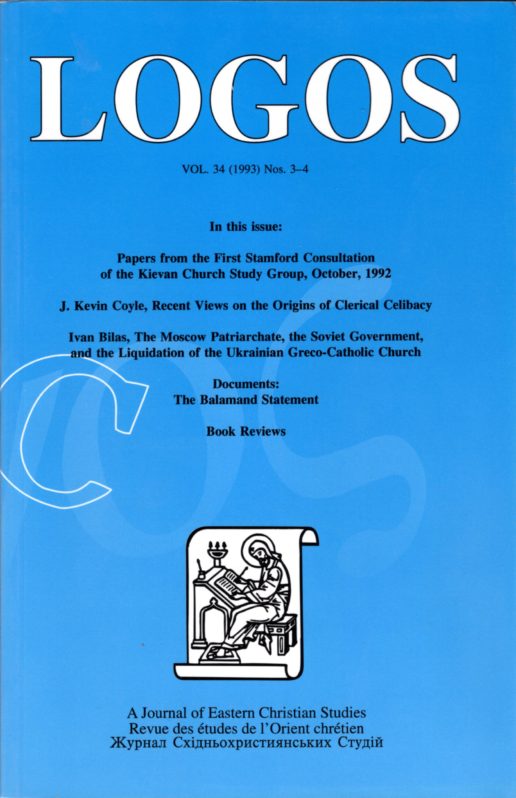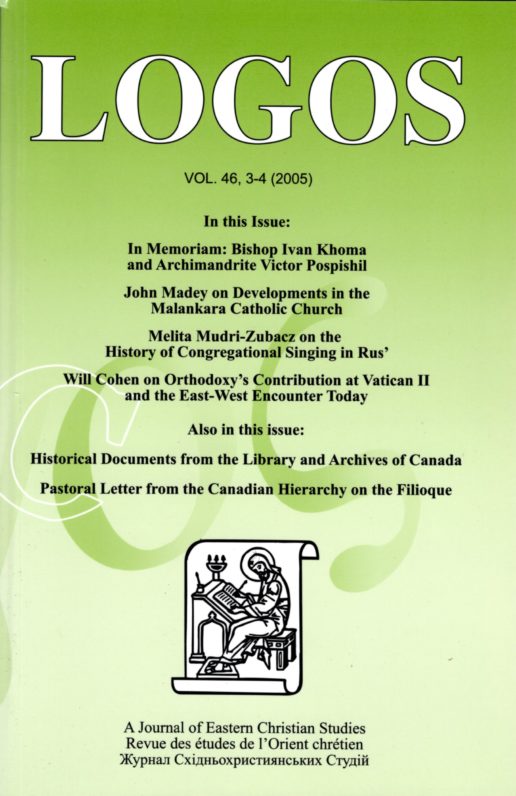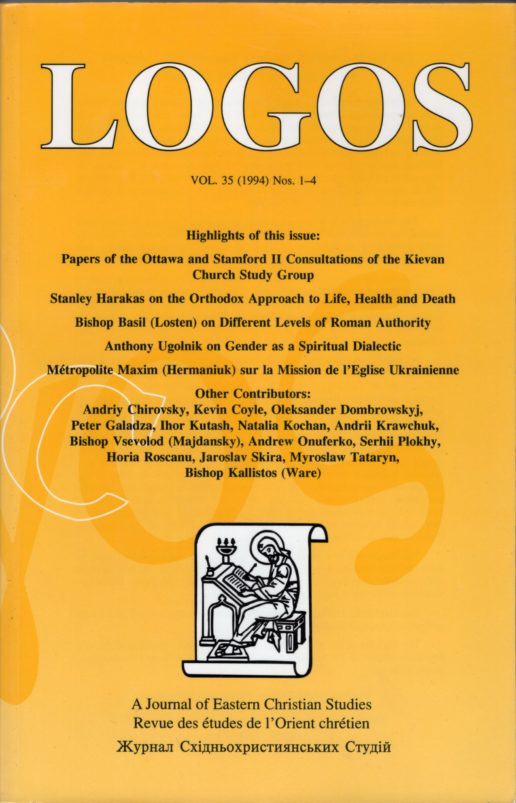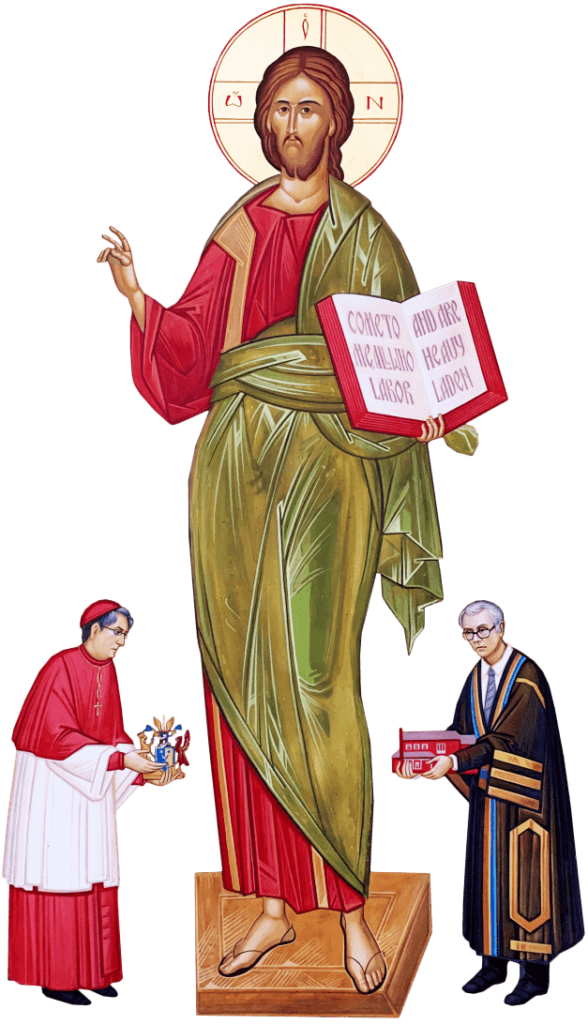Description
Table of Contents (PDF)
Editorial
Tribute to Pope John Paul II
Andriy Chirovsky (1)
Articles
Patriarches d’Orient et d’Occident: similarités et différences. Comment Rome pourrait fonctionner comme l’un d’entre eux? (PDF open access article)
Gregorios III (13)
Abstract
His Beatitude reviews the questions of the office of Patriarch of the West (an historic and legitimate title of the pope of Rome), the so-called pentarchy, the difference between ius divinum and ius ecclesiasticum, and jurisdiction and canonical territory in an era of globalization. He then proposes that further differentiation is called for in order to more clearly understand when the actions of the pope of Rome pertain only to his own Latin Church and when he is acting with pastoral solicitude for the Catholic Church properly so called. Quoting Ratzinger, who in the 1970’s argued for a clearer distinction between pope and patriarch and who advocated the possible creation of new patriarchates, Patriarch Gregory raises a number of ways in which the current functioning of Rome would have to change before proposing two fundamental changes, viz., that the current centralized model of Rome must only be applied to relations and issues internal to the Latin Church and never to the other apostolic, patriarchal Churches; and that the ecclesiastical, and particularly papal, structures of the West are capable of further development and evolution.
Резюме
Глава Мелхітської Католицької Церкви переглядає питання уряду Патріярха заходу (історичний та юридично відповідний титул Папи Римського), так звану „пентархію”, різницю між ius divinum і ius ecclesiasticum, та питання юрисдикціїї та канонічної території в умовах сучасної ґльобалізації. Тоді він висловлюється про необхідність надалі запровадити розрізнення для чіткого розуміння того, коли дії Папи Римського стосуються лише його власної Латинської церкви, а коли він діє як пастир всієї Католицької Церкви в належному значенні цього слова. Цитуючи Ратцінґера, який у 1970-их роках закликав до чіткішого розрізнення між папою та патріярхом, і який обороняв можливе створення нових патріярхатів, Патріярх Григорій піднімає декілька шляхів впровадження необхідних змін в теперішній діяльності Риму, а далі пропонує дві основні зміни, а саме: 1) теперішній централізований модель Риму повинен застосовуватись лише щодо внутрішніх стосунків та проблем Латинської церкви, проте в жодному випадку не у відношенню до апостольських патріярших Церков; 2) еклезіальні, зокрема папські структури Заходу мусять вважатися спроможними на подальший розвиток та еволюцію.
The Bishop in the Tradition of the Eastern Church (PDF sample)
Archbishop Joseph (Raya) (35)
Abstract
Archbishop Joseph provides a synthetic overview of the office of bishop as understood in Eastern Christian theology, weaving together biblical, canonical, patristic, historical, and liturgical threads to show how richly multifaceted the office is. The bishop may be understood as an image of each of the Persons of the Trinity, with the Holy Spirit in particular showing all bishops to be equally yoked in the Lord. This equality is manifested, Raya says, through their collegiality, which is expressed concretely in local synods, ecumenical councils, and the profession of faith made upon the election of a new hierarch – and, in the case of patriarchs, sent to their brother patriarchs. The author then considers the role of the bishop in the search for Christian unity and, quoting Ut Unum Sint, goes on to provide a unique perspective on how to achieve Orthodox-Catholic unity through what some have called the “Zoghby formula.”
Резюме
Архиєпископ Йосиф (Рая) подає комплексний перегляд розуміння уряду єпископа в Східно-християнській богослов’ї, при цьому він cплітає воєдино біблійні, кано нічні, патристичні, історичні та літургійні ниті, щоб показати багатогранність цього уряду. Єпископа можна розглядати як кожну Особу Пресвятої Тройці, в якій особливо Святий Дух показує, що всі єпископи разом несуть ярмо Господнє. Ця рівність, каже Архиєпископ Рая, проявляється у їхній колегіальності, втілення якої, бачимо в помісних синодах та вселенських соборах. Вона також проявляється в ісповіді віри, яка здійснюється напередодні поставлення нового ієрарха, а також у випадку патріярхів, при обранні яких надсилають свою ісповідь віри іншим братам патріярхам. Далі автор розглядає ролю єпископа у пошуку християнської єдності, й цитуючи Ut Unum Sint, навіть подає унікальне бачення того як осягнути єдність між католиками та православними за допомогою так званої „формули Зоґбі,” яку пропагував Архиєпископ Ілля Зоґбі, мелхітський ієрарх-екуменіст.
A Comparison of Swedenborg and Skovoroda’s Biblical Thought (PDF sample)
Stephen P. Scherer (45)
Abstract
By means of an apposite and microscopic analysis of two leading figures of the intellectual history of eighteenth century Europe, viz., Emanuel Swedenborg and Hryhorij Skovoroda, the author is able to bring into macroscopic relief some of the emerging issues of the day, including especially the increasing debate between “rationalism” and “religion” then taking place. Arguing that Swedenborg and Skovoroda were quite likely the leading thinkers of Sweden and Ukraine respectively in this period, the author demonstrates the considerable learning and accomplishments of both by focusing on the similarities and differences each took to the question of biblical interpretation. After a biographical sketch of Swedenborg and Skovoroda, and then a look at their dualistic worldviews, the author focuses in particular on how each regarded the Bible in general and, in particular, how each handled such stories as the creation account in Genesis, the story of Lot and his wife, the flood, Abraham’s sacrifice, and the woman clothed with the sun in the book of the Apocalypse. Swedenborg’s “symbolic-historical” approach to the Bible is compared and contrasted with Skovoroda’s “symbolic-mystical” approach.
Резюме
За допомогою порівняльної та детальної аналізи двох провідних постатей інтелектуальної европейської історії XVII століття а саме, Еммануїла Свіденборга та Григорія Сковороди, авторові вдається детально виділити деякі наявні проблеми даної епохи, а зокрема щораз пожвавленішу полеміку між „раціоналізмом” та „релігією.” В ході дослідження подібностей та відмінностей у підході кожного з цих мислителів до інтерпритації Святого Письма, автор стверджує, що Свіденборг та Сковорода мабуть були провідними мислителями Швеції та України своєї доби, а також показує ґрунтовну освіту, якою володіли цімислителі та їхні здобутки. Після короткого біографічного нарису Свіденборга та Сковороди та погляду на їх дуалістичне світобачення, автор зосереджується на тому, як кожен з них в загальному розглядав Біблію і зокрема як вони тлумачили такі оповіді як сотворення в книзі Буття, історію про Лота та його дружину, про потоп, жертву Авраама та жінку зодягнену в сонце в книзі Об’явлення. „Символічно-історичний” підхід Свіденборга до Святого Письма порівнюється та протиставляється „символічномістичному” підходові Сковороди.
Politics, Property Restitution, and Ecumenism in the Romanian Orthodox Church (PDF sample)
Michael Mates (73)
Abstract
The author examines one of the most hotly contested and ecumenically difficult issues today, the state of the Greek Catholic Church (“Uniates”) in Romania and its relationship to the Romanian Orthodox Church, focusing in particular on the very difficult issue of property forcibly taken from the Romanian Greek Catholics in 1948 and given to the Romanian Orthodox. After providing a brief overview of Romanian secular and ecumenical-ecclesiastical politics, the author notes that the Greek Catholics have encountered a series of roadblocks in their attempts to have the question of property restitution addressed justly and fairly, and the author critically examines the role of the Romanian Orthodox in this situation, arguing that much Orthodox conduct in this regard is at odds with Orthodox relationships with other religious bodies and at odds with its own theology. This examination provides a microscopic overview of two larger, still unsettled problems: that of negotiating a new Church-state relationship following the collapse of communism in 1989; and that of rebuilding Orthodox-Catholic relations, in Romania and elsewhere.
Резюме
Автор розглядає одну з найбільш суперечливих та з екуменічної точки зору найскладніших проблем сьогодення, а саме становище Греко-Католицької церкви в Румунії і її стосунки з Румунською Православною Церквою. Зокрема він зосереджується на дуже складному питанні нерухомостей – храмів та інших маєтків, які в 1948 році були насильно відібрані від греко-католиків і передані Румунській Православній Церкві. Після короткого огляду румунської світської та екуменічно-еклезіальної політики, автор зазначає, що греко-католики наштовхнулися на ряд перепон, коли пробували законно та справедливо вирішити питання повернення свого майна. Також автор критично розглядає у цій ситуації ролю румунських православних, стверджуючи, що поведінка православних у цьому питанні у відношенню до греко-католиків здебільшого суперечить їх же поведінці, коли йдеться про інші релігійні групи і навіть суперечить їх власному богослов’ю. Це дослідження подає дуже детальний огляд двох більших все ще нерозв’язаних проблем, а саме необхідність розпрацювання нових стосунків між Церквою та державою в обставинах після падіння комунізму у 1989 Politics and Ecumenism in the Romanian Orthodox Church 93 році, а також проблему відбудови православно-католицьких стосунків в Румунії і поза її межами.
The Rebirth of Communion Ecclesiology within Orthodoxy: From Nineteenth Century Russians to Twenty-First Century Greeks (PDF sample)
Ernest Skublics (95)
Abstract
Noting that eucharistic or communio ecclesiology has been widely and influentially discussed in contemporary theology, both Eastern and Western, the author provides a history of this ecclesiology in Orthodoxy, tracing its roots to, inter alia, the Slavophile movement of the late nineteenth century as seen in such figures as Alexi Khomiakov, Sergei Bulgakov, and Nikolai Berdyaev. This movement in turn had an influence on more recent figures such as Georges Florovsky, Justin Popovich, Dumitru Staniloae, Vladimir Lossky, Nicholas Afanasiev, and Alexander Schmemann. In addition, communion ecclesiology has had a wide influence beyond its Slavic origins and proponents, and the author also reviews in particular the recent and ongoing work of John Zizioulas, Christos Yannaras, Georgios Mantzaridis, and Panagiotis Nellas. The author concludes by noting that communion ecclesiology is intimately tied up with issues of theological anthropology and theological ethics, issues which invite further development.
Резюме
Беручи до уваги, що євхаристійна еклезіологія або еклезіологія сопричастя широко та авторитетно обговорюється в сучасному як східньому так і західному богослов’ях, автор подає історію цієї еклезіології в православ’ї. Він простежуює її коріння поміж іншими і в слов’янофільському русі кінця ХІХ століття, представленого такими постаттями як Алексей Хомяков, Сергій Булгаков та Николай Бердяєв. Цей рух, в свою чергу, вплинув на такі ближчі до нас постаті, як Георгій Флоровський, Юстин Попович, Дімітру Станілоя, Влодимир Лосский, Ніколай Афанасьєв та Олександр Шмеман. Поряд з цим еклезіологія сопричастя мала значний вплив і поза межами свого слов’янського походження та її оборонців. Автор також робить огляд зокрема нещодавніх творів Йоана Зізіуласа, Хрістоса Янараса, Георгія Манцарідіса та Панагіотіса Нелласа. Скублікс приходить до висновку, що еклезіологія сопричастя тісно пов’язана з проблемами богословської антропології та богословської етики, a ці питання вимагають подальшого розвитку.
The Journey after Death and the Toll-house Myth: A Comparative Study of the Theology of After-life in East and West (PDF sample)
Sherri Vallee (125)
Abstract
In the spirit of Unitatis Redintegratio, the author suggests that the differences in Eastern and Western concepts of what happens after death need to be more fully explored, but that such exploration already reveals three points of commonality: an intermediate state between death and resurrection, the need for many to experience purification or ongoing growth during this period, and the belief that prayers and liturgical celebrations can somehow aid these souls. In addition to the similarities there are also of course areas of difference in the method of purification, the degree of attention given to the final judgment and to the resurrection of the body, and the willingness to acknowledge the reality of death. After reviewing the Latin tradition’s emphasis on “purgatory” and the Orthodox theologumena about “toll-houses” and “soul slumber,” the author concludes that in a death-denying culture such as ours today, both theologies offer much that is worthwhile to the Churches to ponder and offer to their faithful for consideration and consolation.
Резюме
У дусі Unitatis Redintegratio, автор висловлюється про необхідність глибшого вивчення різниці між східною та західною концепціями про те, що стається з людиною після смерті. Проте, вже саме дослідження цієї теми свідчить про існування трьох спільних точок а саме: 1) проміжний стан між смертю та воскресінням; 2) потреба для багатьох пройти очищення або ж подальший зріст впродовж цього часу; та 3) віра в те, що молитви та літургійні відправи якось можуть допомогти цим душам. Звичайно ж, що окрім подібностей існують також розбіжності, а зокрема щодо способу очищення, щодо того як багато уваги приділяється події судного дня та воскресінню тіла, а також щодо бажання визнати реальне існування смерті. Після того, як автор розглядає наголос, який робиться в латинській традиції на „чистилищі” та Православний теологумен про „митарства” та несвідомий стан „сплячої” душі після смерті, вона приходить до висновку, що в сьогоднішній культурі, де люди уникають дійсність смерті, або заперечують її зовсім, обидва богослов’я володіють тими ресурсами, які вартують того, щоб Церкви подали їх на роздуми та розраду своїм вірним.
Documents
Suggestions For The Renewal Of Our Church (151) Open access PDF
Memorandum of the Canadian Clergy (159) Open access PDF
Impatience and Intolerance: Facts for a Future Historian to Analyze (169)
Luhovey-Muzyka Correspondence about the 1965 Conference (181)
An Open Letter to the Most Rev. Archbishop M. Hermaniuk, CSSR, DD (185)
A Proposal Regarding Areas of Ukrainian Catholic Church Life That Deserve Discussion and Action (189) (open access)
Notes, Essays, Lectures
“Behold You Are Beautiful:” Theological Anthropology in Light of the Theotokos (PDF sample)
Gregory Jensen (197)
The Legacy of Pope John Paul II and Ukraine (PDF sample)
Bishop Basil (Losten) (211)
Pope John Paul II and Ukrainian Catholic Liturgical Life: Renewal of Eastern Identity (PDF sample)
Mark M. Morozowich (221)
Book Reviews
Constantine Cavarnos, Guide to Byzantine Iconography
Shawn Tribe (245)
John Chrysostom, Spiritual Gems from the Book of Psalms
Danylo Kuc (248)
Andreas Kappeler, Zenon E. Kohut, Frank E. Sysyn, and Mark von Hagen, eds., Culture, Nation and Identity: The Ukrainian-Russian Encounter, 1600–1945
Peter Galadza (251)
Contributors (261)
Language: English, French, Ukrainian
Softcover: vi, 288 pages
Publisher: The Metropolitan Sheptytsky Institute of Eastern Christian Studies
ISSN: 0024-5895
Digital File: $20
Size: 6 MB
A link to the PDF file of this title will be sent to you. The PDF file is for your personal use only. You may not copy, share, publish, or sell the file. Protected by copyright of the Metropolitan Andrey Sheptytsky Institute of Eastern Christian Studies.






